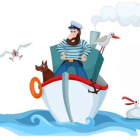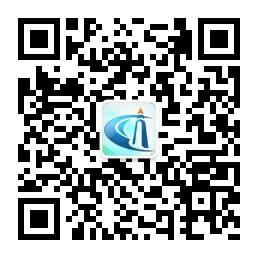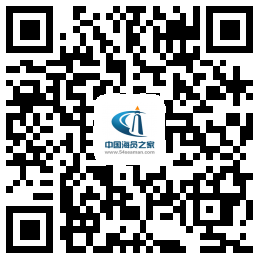麦哲伦海峡引航及自引
船舶简介
船名:MV INTERLINK PARITY / V7VP4 / 9486594
船型:47,000吨便利型散货船+4台甲板克令吊
总长:189.99米
型宽:28.50米
型深:15.10米
吃水:10.20米
航速:13.5节
我轮于2014年5月5日在智利的CALETA PATILLOS港装载33,000.00吨岩盐 (ROCK SALT) 去阿根廷的CAMPANA港,途经麦哲伦海峡,全程引航员引航。于2014年6月13日在阿根廷的SAN LORENZO港装载33,600.00吨玉米和大豆到秘鲁的CALLAO港。再次途经麦哲伦海峡,短程引航员引航,剩余航段自引。
海峡简介
智利,位于南美洲西南极端,拥有2,400海里的海岸线,其中沿南纬41度45分以南的1095海里的海岸线是众多的海峡和峡湾,这些海峡海湾对船舶在智利内陆水域的安全航行提供了良好的保护。麦哲伦海峡就是这些海峡中最著名的,全长约313海里,连接太平洋和大西洋。西起EVANGELISTAS (52-23.5S, 075-06.0W) 灯塔,即C.PILAR入口;东至POSESION BAY (52-22.0S, 069-01.0W) 引航站。
智利沿岸可以划分为三个区域:
智鲁岛和艾森地区,从南纬41度45分到47度00分;
巴塔哥尼亚地区,从南纬47度00分到麦哲伦海峡;
火地岛地区,从麦哲伦海峡到和恩角,这是大陆最后庇护的地方,多半经此前往南极。
南纬40度以南的气候多变,风力海况整年以突变为特征,一日可以经历四季!低的低气压和锋面由西向东再向东南移动,从而变得更强。巨大的涌浪总是由西向东自南太平洋毫无遮拦地一路狂卷过来,有时无风也三尺浪。从三月到八月份(秋季和冬季),风暴或大风和低压锋面一道带来强劲的西到北风和西北风。而通常在春季和夏季(九月到三月),南风和高压系统可能非常强劲,尤其是在巴塔哥尼亚地区一带。
智鲁岛和艾森地区在冬天多雨,夏天(十二月到三月)天气晴朗,但阵雨也如期而至。巴塔哥尼亚和火地岛地区全年多雨且寒冷,夏季是巴塔哥尼亚的著名“风季”,冬天从五月到八月份,更冷并且多半下雪。通常这个时候有雾且风平浪静,在一些海峡可以看到小的冰山和浮冰。
航路航法-引航
1、强制引航航段
1)如果船舶来自智利港口或将要挂靠智利港口,则麦哲伦海峡全程包括智利西海岸41-45S以南区域强制引航。即从东边的POSESION BAY引航站到西海岸的ANCUD (41-48.0S, 073-50.4W)引航站, 反之亦然-也称做全程引航或长引航(LONG PILOTAGE - COMING / CALLING ANY CHILEAN PORT )。如果船舶总长超过230米和吃水超过11米,则必须在LAITEC (43-19.0S, 073-36.0W) 引航站上引水。
2)如果船舶不是来自智利港口也不挂靠智利港口,则强制引航仅要求从东边的POSESION BAY引航站到海峡内的PUNTA ARENAS (53-10.0S, 070-52.0W) 引航站,反之亦然-也称短程引航 (SHORT PILOTAGE - NOT COMING / CALLING ANY CHILEAN PORT)。
3)西海岸从ANCUD到和恩角 (CAPE HORN) 的其他内水水域,海峡和峡湾都强制引航。
4)提请注意的是如果天气海况不好,引水员可能在PUNTA DELGADA (52-26.0S, 069-28.0W) 引航站附近或者其与POSESION引航站之间上下船,具体情况根据交管控制台 (VTS) 和引水的指示执行。
2、高度推荐引航航段
从麦哲伦海峡西面入口的FELIX BAY (52-53.0S, 074-00.0W)到PUNTA ARENAS引航站为高度推荐引航航段。尤其对超大型船舶及油船,液化气船及化学品船等特殊船舶。
3、航路简介
1)东行
在ANCUD引航站上引水后,可以视情况掉头出来直接沿着智利西海岸南下到麦哲伦海峡西面入口C.PILAR进入海峡;或者直接通过CANAL CHACAO水道进入内水航道,通过内水航道及海峡进入麦哲伦海峡。众多的内水航道和海峡对船舶通行都有不同的要求和限制,有的限制船长,有的限制吃水,有的根据涨落潮时间或者日出日落的时间来限制通行;又或者单一限制,或者综合限制等等,就不一一赘述,反正内水水域都是强制引航,具体引航员会详细告知并选定最佳航路。两名引航员在船工作近4天,最后圆满完成引航任务,每位船员都获得一份《智利麦哲伦航行证书》,引航员受天气海况影响提前在PUNTA DELGADA引航站离船。
2)西行
前面提及在POSESION BAY引航站上下引水都受天气海况的影响。这次我轮于6月20日1515LT到达后又遇不利天气,按指示继续前行,在途中于1600LT接到一名短程引航员。由于顺流航速最高达19节,引航员于当日2200LT在PUNTA ARENAS引航站离船,全程共6小时。引水离船前详细告知船长前面剩余航路的航行注意事项,报告点,船舶动态以及天气情况。非常绅士非常尽职!
4、其他注意事项
1)ANCUD引航站位置有限,(41-47.0S, 073-51.2W; 41-47.0S, 073-49.2W; 41-48.3S; 073-51.35W; 41-48.3S, 073-49.47W),现有可用的英版海图BA4250比例太小,不利于安全。建议有条件的话多上一张智利海图(CHILE 7210)。需要注意不要靠近引航站东面区域,东面都是浅滩,尤其当避让由CANAL CHACAO过来的出口船时需要格外引起重视!
2)POSESION BAY引航站靠近外海,易受天气影响,需要加强和信号台及引航站的联系。另外附近多油井平台,需要谨慎操作,确保船舶安全。
航路航法-自引
1、西行
从PUNTA ARENAS引航站下引水后直接往南,与PTA SANTA ANA海岬保持2.4海里的安全距离,与C.DAN ISIDRO海岬保持2.1海里的安全距离, 与RUPERT小岛, CARLOS III岛以及C.CROSSTIDE 和C.QUOD海岬保持0.5海里安全距离,顶流时注意尽量抱紧背流岛屿航行,以防止航道开门时走偏。尤其当这种狭长型便利船在重载状况下,更易受顶流影响。最后在海峡出口处根据具体海浪情况调整航向,避免过分横摇及与AVANGELISTAS灯塔保持安全距离。防止一年到头的从西而来的巨大涌浪将船推往浅滩。
2、东行
进峡航向调整到108度左右,并尽量与AVANGELISTAS灯塔保持6海里以外距离进入海峡,其他可参考西行航法。顺流留意舵效,把握转舵时机,勤用小舵角,忌用大舵角,尤其狭窄急弯航道处,避免急流扫尾造成船舶难以控制。
通讯及报告
相关的详细报告制度可以在《港口指南-PORTS & TERMINALS GUIDE》和《英版无线电信号表-ADMIRALTY LIST OF RADIO SIGNALS-NP281(2) & NP286(7)》中查找,也可直接向海峡代理咨询。以下谨以实际操作加以概述,希望对第一次过海峡的朋友有所帮助。
1、东行(全程引航)
首先和代理联系并递交一些简单的证书文件,比如国际吨位证书及船员名单等,代理会告诉具体的引水登船位置。
其次虽然CHILREP报告不是强制,但智利海事机关要求每天1200Z (0800LT) 和2400Z (2000LT) 报告船位。具体格式附后。
引航途中其他报告都由引水完成,下引水后,在抵达海峡出口处正横PUNTA DUNGENESS灯塔或其与CABO ESPIRITU SANTO灯塔之间连线(SECOSENA LINE)时在VHF16呼叫PUNTA DUNGENESS RADIO STATION并向其报告通过时间及其他一些如目的港及ETA等常规信息。同时也向阿根廷的TRINIDAD RADIO STATION报告,你不叫他岸台自己也会叫过来。西行船一样。
2、西行(短程引航+自引)
同样提前和海峡代理取得联系。
正横PUNTA DUNGENESS灯塔时向PUNTA DUNGENESS岸台报告正横时间及ETA POSESION BAY引航站及确认引水登轮地点,同时也向阿根廷的TRINIDAD岸台报告。
引航途中都由引水自己报告,船长只负责一天两次通过E-Mail发送的船位报。
引水离船后上述船位报增加为每4小时一次,发邮件就可以了。
另外引水在PUNTA ARENAS离船后,以下报告需要船长通过VHF自行完成。
距离正横C.CROSSTIDE LIGHTHOUSE (53-33.6S, 072-25.2W) 1小时之前在VHF16频道公报安全信息。内容大约如下:SECURITY, SECURITY, SECURITY, M/V XXXX, CALL SIGN XXXX, FROM WEST TO EAST, ETA PASS ABEAM CROSSTIDE LIGHTHOUSE XXXX LT. OVER.
正横COHORN LIGHTHOUSE (53-33.0S, 072-20.2W) 时向智利海军控制台(ALCAMAR TORTVOSO STATION) 报告正横时间以及预计到达FELIX LIGHTHOUSE (52-57.6S, 074-03.8W), EVANGELISTAS LIGHTHOUSE (52-23.5S, 075-06.0W) 以及目的港的时间(ETA)。
正横 FELIX LIGHTHOUSE 时报告灯塔岸台 (FELIX LIGHTHOUSE STATION) 正横时间及预计到达 EVANGELISTAS LIGHTHOUSE 以及目的港的时间。
最后正横 EVANGELISTAS LIGHTHOUSE 时报告灯塔岸台(EVANGELISTAS LIGHTHOUSE STATION) 正横时间以及航速等信息。
离开海峡后在智利水域内保持每天两次的船位报即可。
其他引航状况
东行自引+短程引航没有实际经历过,故不便发表意见。想来可以参考上述2)反其道而行之。
各报告点之间的距离供参考。
0’ ----- POSESION BAY P/S (52-22.0S, 069-01.0W)
22’ ---- PUNTA DELGADA (5226’S, 06928’W)
70’ ---- PUNTA ARENAS (53-10.0S, 070-52.0W)
99’ ---- ALCAMAR TORTVOSO STATION (53-33S, 072-20.2W)
72’ ---- FELIX LIGHTHOUSE (52-57.6S, 074-03.8W)
50’ ---- EVANGELISTAS LIGHTHOUSE (52-23.5S, 075-06.0W)
全程共计313海里。
6、其他
海图
麦哲伦海峡需要备齐下列英版海图:
BA1692, 1693, 1694, 4267, 4266, 4265, 4264, 4263, 4262, 4259。
全程引航还需增加BA4250, 4255, 4258以及智利海图CHILE 7210!
船位报告格式
TO: DIRSOMAR
FM: MV XXXX XX/EE43A
CHILREP P/R
FORMAT EXAMPLE
A (SHIP NAME/CALL SIGN) MV XXXX XX/EE43A
B (POSN DATE/TIME LT) 140800LT
C (POSN) 4220S / 07715W
E (COURSE) 180
F (SPEED) 13.5
S (PRESS, WIND, TEMP) 1025 / WLY 7 / 15
X (REMARKS, IF ANY) ETA PUNTA ARENAS P/S 220800LT
附图供参考
TRANSITING MAGELLAN STRAITS
-- UNDER PILOTAGE AND WITHOUT PILOTAGE --
-- CATP. ZENG XIAOYONG
SHIP’S PARTICULARS
NAME: INTERLINK PARITY/V7VP4/9486594
TYPE: 47,000 MTS HANDY BULK BARRIER WITH 4 SETS DECK CRANES
LOA: 189.99 M
BREATH: 28.50 M
DEPTH: 15.10 M
DRAFT: 10.40 M
SPEED: 13.5 KNOTS
My vessel loaded cargo of 33,000 mts of Rock Salt at Caleta Patillos, Chile on May 5, 2014 and then passed through the Magellan straits with long pilotage to the Campana port, Argentina for discharging. And then loaded cargo of 33,600 mts of Grain at San Lorenzo, Argentina on Jun 13, 2014 and again passed through the Magellan straits with short pilotage to the Callao, Peru for discharging.
MAGELLAN STRAITS
Chile, on the extreme SW of South America has 2,400 miles of sea coast, and within them, south of Latitude 41-45S, are 1,095 miles of channels and fjords, providing well-protected inland waters for safe navigation. The Strait of Magellan is the best known of these channels, and runs for 313 miles from the Pacific to the Atlantic. The West entrance is from the Evangelistas Lighthouse (52-23.5S, 075-06.0W) on the opposite of the C.Pilar, and East is from the Posesion Bay pilot boarding area (52-22.0S, 069-01.0W).
Three areas can be distinguished for Chilean coast: from 41-45S (Canal Chacao - Ancud) to 47-00S (Glofo de Penas) known as Chiloe and Aysen; from 47-00S to Magellan Strait is Patagonia, and from there to Cape Horn, Tierra del Fuego. This last sheltered region is the most used passage to reach Antarctica.
South of Latitude 40S, sudden changes in wind and sea conditions are characteristic all throughout the year. It is said that the four seasons can be experienced on the same day. Low pressure depressions and fronts move from W to E and SE, becoming stronger as they gain in latitude. Heavy swells are always with a west component, boisterously coming from South Pacific Ocean without any shelter. Sometimes heavy swells can be received even if without wind. Storms and gales coming with low pressure fronts bring strong W to N and NW winds, mostly from March to August (autumn and winter). Southerly winds, with high pressure systems, can be very strong, especially in Patagonia. They are more common during Spring and Summer (September to March).
Chiloe and Aysen areas are rainy, mostly in winter. In summer (December to March), weather can be fair, but showers can be expected. Patagonia is known as the “windy” season. Winter is colder and it snows mostly from May to August. Fog and calms are also common at this time. Small icebergs and pack ice can be found in some of these channels.
ROUTING AND MANOEUVRING - UNDER PILOT
1. PILOTAGE IS COMPULSORY.
a. It is compulsory navigating under pilot for the whole Magellan Straits and the South of 41-45S of the West coast of Chilean, i.e., from Posesion Bay pilot station (52-22.0S, 069-01.0W) to the Ancud pilot station (41-48.0S, 073-50.4W) or vice versa if the vessel is coming and/or calling any Chilean port. It is also called as “long pilotage”. For vessels over 230 m of LOA and over 11 m of draft must transfer the pilot at Laitec pilot station (43-19.0S, 073-36.0W).
b. It is only compulsory navigating under pilot for the part of Magellan Straits from Posesion Bay pilot station (52-22.0S, 069-01.0W) to Punta Arenas pilot station (53-10.0S, 070-52.0W) or vice versa if the vessel is not coming and/or calling any Chilean port. It is also called as “short pilotage”.
c. Pilotage is compulsory for navigating inner waters, channels, fjords, between Ancud and Cape Horn.
b. Please be noticed that pilot embarking and disembarking area may be changed to Punta Delgada pilot station (52-26.0S, 069-28.0W) or between it and Posesion Bay pilot station due to prevailing weather condition. Just to follow the instructions from VTS or pilots.
2. PILOTAGE IS HIGHLY RECOMMENDED
It is highly recommended for vessels navigating in the area between Punta Felix (52-53.0S, 074-00.0W) and Punta Arenas (53-10.0S, 070-52.0W). In particular for special vessels such as VLCC, LNG, LNP, OIL and CHEMICAL tanks, etc.
3. ROUTES
a) Eastbound
After picked up pilots at Ancud pilot station, you may turn around your vessel to the open sea then directly go along the coast to the western entrance of Magellan Straits via C.Pilar. Or you can ask for pilots to proceed to Magellan Straits via Canal Chacao, inner waters and channels and fjords as per weather conditions and ship situations. There are much and different requirements and restrictions for the vessel navigating in those inner channels and fjords. Those restrictions basis on the situation such as ship’s LOA, draft, tide windows and sunset or sunrise, etc., and singly restricted by one or by multiplicities of those situations. It is unnecessary to describe one by one here because the pilots will advise you in details and to make a best route for you and you are not allowed to navigate in inner waters without pilot.
Pilotage smoothly completed and issued the “Magellan Navigation Certificate” to every crew members on board after two professional pilots worked on board for about 4 days. Pilots disembarked at Punta Delgada pilot station (52-26.0S, 069-28.0) due to heavy weather encountered.
b) Westbound
As above-mentioned, it is affected by the prevailing weather for pilot embarking and/or disembarking at Posesion Bay pilot station. My vessel arrived at the Posesion Bay pilot boarding area at 1515Lt on 20 Jun 2014 and encountered heavy weather again this time, so I continuously proceed to the Punta Delgada according to the instruction from Punta Dungeness Station and pilots, and picked up one pilot for the short pilotage at 1600Lt en route. Ship’s speed increased to 19 knots by the favorable current and the pilot disembarked at 2200Lt at Punta Arenas pilot station. Total is 6 hours only. The pilot who advise Master all the navigation notice, report point, ship movement and weather forecast in detail for the remaining route. They are gentlemen and very helpful.
4. OTHER NOTICE
a) The space is smaller and confined at Ancud pilot station (41-47.0S, 073-51.2W; 41-47.0S, 073-49.2W; 41-48.3S; 073-51.35W; 41-48.3S, 073-49.47W). The scale is too small for the usable BA chart 4250 and it is unsafe for operation. It is highly suggested to request one more Chilean chart 7210 for safe operation. You should pay more attention to the shallow water on the eastern of the pilot boarding area in particular when you keep away from the vessels come out of the Canal Chacao.
b) It is close to the open sea and easily affected by the weather for the Posesion Bay pilot station. So that it is necessary to make close contact with shore station and pilots. And there are many oil rigs / platforms around the pilot station, please take manoeuvring carefully to ensue ship safety.
ROUTING AND MANOEUVRING - SELF-PILOTAGE
1. WESTBOUND
After disembarking pilot at Punta Arenas, directly proceed to south and keep safe distance 2.4 nm from the Pta Santa Ana, and 2.1 nm from C.Dan Isidro, and 0.5 nm form Rupert islands and Carlos III islands, and 0.5 nm form C.Crosstide lighthouse and C.Quod. It is necessary to pay more attention to keep closer the islands back when navigation go against current so as to avoid crossing track when the channel view is opening. It is more easily affected by the adverse current in particular for handy carriers under laden condition. And then finally adjust the course at the west entrance of the straits as per the sea wave and swell situations to avoid heavy rolling and keep safety distance from the Avangelistas lighthouse to prevent the huge west swell throughout the year to push vessel in the shallow water.
2. EASTBOUND
To keep heading about 108 degrees when entering Magellan straits and keep safety distance more than 6 nm from Avangelistas lighthouse. Others please refer to the westbound route. To pay more attention to the steering reaction when navigating with favorable current, it is better using more small steering orders instead of larger steering order or full order in particular when navigating in the narrow and blind bend bay so as to avoid ship out of control due to the strong current push astern.
COMMUNICATIONS AND REPORTS
Relevant reports in detail can be found in the republications of <PORTS & TERMINALS GUIDE> and <ADMIRALTY LIST OF RADIO SIGNALS-NP281 (2) & NP286 (7)>. And also can be obtained from the Straits agent. Hereby record the actual operation as follow and hope it can be a needful for anyone to transit the straits on the first time.
1) EASTBOUND (LONG PILOTAGE)
The first is to contact with straits agent and submit some certificates and documents such as “International Tonnage Certificate” and crewlist, etc. Agent will inform you the particular pilot boarding area.
The CHIREP report system is not compulsory for foreigner ship but the Chilean Maritime Authorities has required the daily position report at 1200Z (0800Lt) and 2400Z (2000Lt). The format is attached in the end.
Others report totally made by pilots on the way.
In the last, after pilot disembarked, to report to the Punta Dungeness Radio Station on VHF channel 16 the time when vessel pass abeam the Punta Dungeness lighthouse or pass the line between it and Cabo Espiritu Santo lighthouse (SECOSENA LINE) and some common message such as cargo type, cargo quantity, destination, ETA, etc. In the same time you should report to the Argentinean Trinidad Radio Station on channel 16. He will call you if you forget to report. This report is same required for the westbound vessel.
2) WESTBOUND (SHORT PILOTAGE AND SELF-PILOTAGE)
The first is to contact with straits agent like eastbound.
To report to the Punta Dungeness Radio Station on VHF channel 16 the time when vessel pass abeam the Punta Dungeness lighthouse and ETA to Posesion Bay pilot station and to confirm the pilot boarding place and time, etc. In the same time you should also report to the Argentinean Trinidad Radio Station on channel 16.
Pilot will be responsible fully for report during the way under pilotage; Master is responsible for the daily position report to the Chilean Maritime Authority twice per day via E-mail. And this daily position to be increased to report every 4 hours without pilot on board.
And the following report to be made by Master via VHF after pilot disembarked.
a) A public security message should be made 1 hour before crossing abeam the C.Crosstide lighthouse (53-33.6S, 072-25.2W) on VHF 16. For example: SECURITY, SECURITY, SECURITY, M/V XXXX, CALL SIGN XXXX, FROM WEST TO EAST, ETA PASS ABEAM CROSSTIDE LIGHTHOUSE XXXX LT. OVER.
b) The Chilean naval control station (Alcamar Tortvoso Station) should be reported with the time you pass abeam the Cohorn lighthouse (53-33S, 072-20.2W) and the ETA to Felix lighthouse (52-57.6S, 074-03.8W), Evangelistas lighthouse (52-23.5S, 075-06.0W) and the destination.
c) The Felix Lighthouse Station should be reported when you pass abeam the lighthouse with the time and ETA to Evangelistas lighthouse and the destination.
d) Finally the Evangelistas Lighthouse Station should be reported when you pass abeam the lighthouse with time and speed and some information as required.
e) The daily position should be kept twice per day after leave the straits within Chilean water.
3) OTHER PILOTAGE
a) Eastbound self-pilotage + short pilotage. It may be referred to the above 2) but this is uncertain without experience.
b) The distance between the report points as follow for your reference only.
0’ ----- POSESION BAY P/S (52-22.0S, 069-01.0W)
22’ ---- PUNTA DELGADA (5226’S, 06928’W)
70’ ---- PUNTA ARENAS (53-10.0S, 070-52.0W)
99’ ---- ALCAMAR TORTVOSO STATION (53-33S, 072-20.2W)
72’ ---- FELIX LIGHTHOUSE (52-57.6S, 074-03.8W)
50’ ---- EVANGELISTAS LIGHTHOUSE (52-23.5S, 075-06.0W)
Total: 313 nm.
OTHERS
1) CHARTS
The following BA charts should be prepared for Magellan straits:
BA1692, 1693, 1694, 4267, 4266, 4265, 4264, 4263, 4262, 4259.
It should be added some more charts as below for long pilotage:
BA4250, 4255, 4258 and CHILE 7210!
2) DAILY POSITION REPORT FORMAT
TO: DIRSOMAR
FM: MV XXXX XX/EE43A
CHILREP P/R
FORMAT EXAMPLE
A (SHIP NAME/CALL SIGN) MV XXXX XX/EE43A
B (POSN DATE/TIME LT) 140800LT
C (POSN) 4220S / 07715W
E (COURSE) 180
F (SPEED) 13.5
S (PRESS, WIND, TEMP) 1025 / WLY 7 / 15
X (REMARKS, IF ANY) ETA PUNTA ARENAS P/S 220800LT
3) Attached drawings for reference only.
[最后编辑于 2018-01-19 17:35 ]
请登录后发帖










 联系我们人工客服
联系我们人工客服



















 :1391995811
:1391995811

